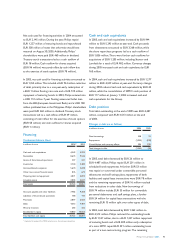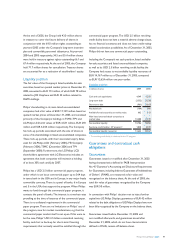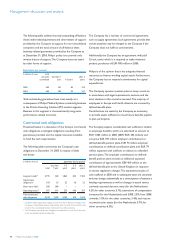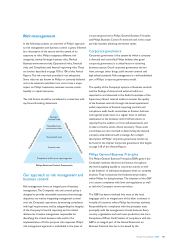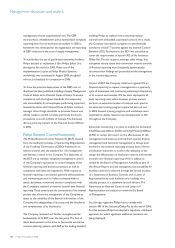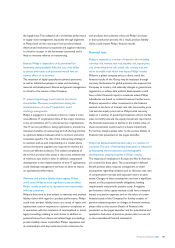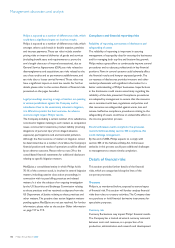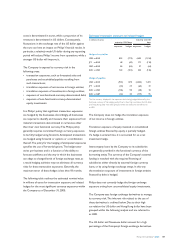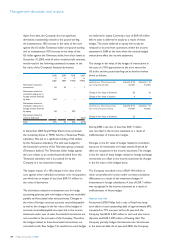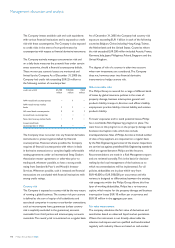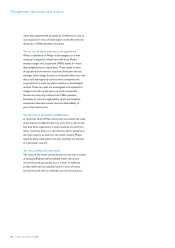Philips 2005 Annual Report Download - page 105
Download and view the complete annual report
Please find page 105 of the 2005 Philips annual report below. You can navigate through the pages in the report by either clicking on the pages listed below, or by using the keyword search tool below to find specific information within the annual report.Philips Annual Report 2005 105
the supply base. The realization of a world-class performance
in supply chain management, especially through alignment
at Philips level on the sourcing of non-product-related,
electrical and mechanical components and supplier reduction,
is critical to success in the businesses concerned and is
likely to increase reliance on outsourcing.
Because Philips is dependent on its personnel for
leadership and specialized skills, the loss of its ability
to attract and retain such personnel would have an
adverse affect on its business.
The retention of highly specialized technical personnel,
as well as talented employees in sales and marketing,
research and development, fi nance and general management,
is critical to the success of the Company.
IT outsourcing strategy could result in short-term
complexities. Moreover, complications during the
implementation of a new IT application could
challenge management.
Philips is engaged in a continuous drive to create a more
cost-effective IT organization. One of the major initiatives
is the consolidation of IT in shared service organizations.
The IT service portfolio is being optimized to provide the
maximum benefi ts of outsourcing and off-shoring and also
an optimum balance between what is common and what
is business-specifi c. The risk of the outsourcing strategy is
to maintain end-to-end responsibility in a model where
various third-party suppliers are required to achieve the
most cost-effective solutions. This added complexity of
the service provision also poses a risk to the achievement
of minimum cost levels in time. In addition, unexpected
development in the implementation of new IT applications
could challenge management and have an adverse impact
on operational performance.
Warranty and product liability claims against Philips
could cause Philips to incur signifi cant costs and affect
Philips’ results as well as its reputation and relationships
with key customers.
Philips is from time to time subject to warranty and product
liability claims with regard to product performance. Philips
could incur product liability losses as a result of repair and
replacement costs in response to customer complaints or
in connection with the resolution of contemplated or actual
legal proceedings relating to such claims. In addition to
potential losses from claims and related legal proceedings,
product liability claims could affect Philips’ reputation and
its relationships with key customers, both customers for
end products and customers that use Philips’ products
in their production process. As a result, product liability
claims could impact Philips’ fi nancial results.
Financial risks
Philips is exposed to a variety of fi nancial risks, including
currency risk, interest rate risk, liquidity risk, equity price
risk, commodity price risk, credit risk, country risk and
other insurable risks which may impact Philips’ results.
Philips is a global company and as a direct result the
fi nancial results of the Group may be impacted through
currency fl uctuations. Its global presence also exposes the
Company to country risk whereby changes in government
regulations or unfavorable political developments could
have a direct fi nancial impact in countries where Philips
subsidiaries are based or conduct business. Furthermore,
Philips is exposed to other movements in the fi nancial
markets in the form of interest rate risk, commodity price
risk and also equity price risk as Philips holds minority
stakes in a number of quoted participations where market
value currently exceeds the equity investment reported in
the fi nancial statements. A decline in the market value of
these investments could result in a future impairment.
For further analysis, please refer to the section Details of
fi nancial risks presented on the pages hereafter.
Philips has defi ned-benefi t pension plans in a number of
countries. The cost of maintaining these plans is infl uenced
by fl uctuating macro-economic and demographic
developments, creating volatility in Philips’ results.
The majority of employees in Europe and North America
are covered by these plans. The accounting for defi ned-
benefi t pension plans requires management to make
assumptions regarding variables such as discount rate, rate
of compensation increase and expected return on plan
assets. Changes in these assumptions can have a signifi cant
impact on the projected benefi t obligations, funding
requirements and periodic pension costs. A negative
performance of the capital markets could have a material
impact on pension expenses and on the value of certain
fi nancial assets of the Company. For further analysis of
pension-related exposure to changes in fi nancial markets,
please refer to the section Details of fi nancial risks
presented on the pages hereafter, and for quantitative and
qualitative disclosure of pensions, please refer to note 22
to the consolidated fi nancial statements.


